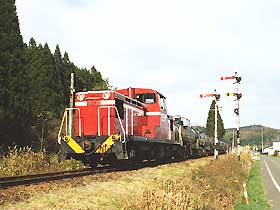
A tanker train passing the down-bound home signals at Shigenai on the Kosaka Railway.
 A tanker train passing the down-bound home signals at Shigenai on the Kosaka Railway.
|
By Hiroshi Naito
Remnants of old British train operation and signal practices still
remain on rural lines off the principal routes in the northern part of
the main island of Japan. One is the Kosaka Railway, an industrial line
operated by Dowa Mining Comapny's Kosaka Refinery, and the other is the
JR Hanawa line. On these lines, single-track traffic is governed by
manual blocking systems that use tablet blocking instruments, which
were copied after the Tyre's system. The signals protecting the loops
are antique down-quadrant 2-position semaphores, which are manually
operated by wires alongside the track.
Click here to see a map of the Kosaka Railway and JR Hanawa line and their vicinities
To dispatch a train to the next section, the station staff calls for
blocking work to the next station using a blocking instrument,
following the specified procedures by means of a bell code and
telephone dedicatedly installed on the instrument. If the actions of
the staff agree with the procedures, a token (tablet) is issued from
the upstream instrument. The token is stored in a leather pouch
attached to a hoop to be carried by the train. The station staff goes
onto the platform with the hoop and hands it to the train driver,
receiving the previous token. The station staff restores the received
token in the blocking instrument to release the previous block. Note
that a station with a loop is equipped with two separate blocking
instruments for both directions, which release different tokens that
can be distinguished by the notches on their sides.
The signals are independently operated by signal levers concentrated
near the station building. The station staff manually reverses or
restores the lever into position to clear or cancel the signal. The
lever activates the semaphore by means of wires strung alongside the
track. The switch points are manually thrown at the location, or spring
points, which are more common at intermediate loops. If interlocking is
required, the signal wire passes through a locking device placed
adjacent to the points, securing a clear aspect with the direction of
the points.
At the dawn of the railway age, Japan recieved financial and technical
support from Great Britain. Because of this, Japanese signaling and
operation were strongly influenced by British practices. Traffic was
principally governed on both double-and single-track territory by
manual blocking instruments from signal boxes located at each boundary
between sections. Around the 1900s to 1920s, many signal engineers went
abroad to study Western signal technology, mostly to the U.S. As a
result, advanced American technology was actively introduced, and the
majority of double-track lines had been resignaled by the 1940s with
automatic blocking signals, first with 3-position upper-quadrant
semaphores and then color light signals. Nevertheless, British manual
blocking practice remained on single-track territory untill it was
superseded from the 1960s to 1980s by automatic blocking systems
associated with CTC systems, first on principal lines and then on
branch lines. Now, these old signal practices have almost died out,
wiht only a few remaining in service far away from urban areas.